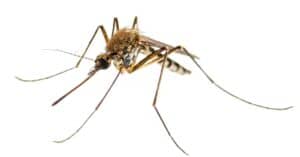In the vibrant landscapes of North Carolina, a common foe buzzes around the state: the mosquito. From those that bite under cover of night to those that relentlessly pester during the day, mosquitoes possess an uncanny ability to find their targets with unwavering determination.
In this article, we’ll explore North Carolina’s mosquito population as we unravel the captivating characteristics of these insects and delve into the challenges they present to the residents of the Tar Heel State.
1. Northern House Mosquito (Culex pipiens)

They can often be found indoors and near human-made structures.
©Anest/Shutterstock.com
One of the most common species of mosquitoes in North Carolina is the northern house mosquito.
Their coloration ranges from dark brown to tan, with distinct brown and white stripes alternating on the top of their abdomen.
They can often be found indoors and near human-made structures. The breeding habits of northern house mosquitoes are similar to those of other mosquito species, as they prefer stagnant or still water areas for reproduction. In the past, they were even referred to as “rain barrel mosquitoes” due to their tendency to breed in such containers.
A diverse range of hosts, including humans, dogs, and birds, serve as food sources for female northern house mosquitoes. These mosquitoes are notorious for infiltrating buildings, including residential homes, to obtain blood meals from humans.
They are most active during the hours immediately after sunset. Additionally, adult mosquitoes also feed on nectar and other sugary food sources to accumulate fat reserves.
These mosquitoes and their close relatives are carriers of several dangerous diseases that can have severe consequences, making them a significant threat in North Carolina. The most worrisome diseases transmitted by these mosquitoes include St. Louis encephalitis, West Nile virus, and Eastern equine encephalitis.
These mosquitoes remain a persistent nuisance for North Carolina residents from the beginning of spring until early fall.
2. Eastern Saltmarsh Mosquito (Aedes sollicitans)
The eastern salt marsh mosquito is a mosquito species found in the coastal areas of North Carolina. They are naturally inclined to breed in marshlands and strongly prefer seeking hosts to feed on.
In terms of appearance, these mosquitoes have a primarily black proboscis that stands out with a distinctive white scale band encircling its middle. The interplay of dark and pale scales gives them a unique look.
This species’ female mosquitoes have a well-known tendency for persistent biting as they look for blood meals from various animals such as birds, reptiles, and mammals, with humans being a particularly preferred target. Their habitat range typically extends within approximately 5 miles of the coast, although it can vary depending on factors such as wind speed and other factors.
One of the concerning aspects of these mosquitoes is their ability to transmit equine encephalitis, a rare yet severe disease. In North Carolina, these mosquitoes reach their peak population during the spring and fall seasons.
3. Asian Tiger Mosquito (Aedes albopictus)
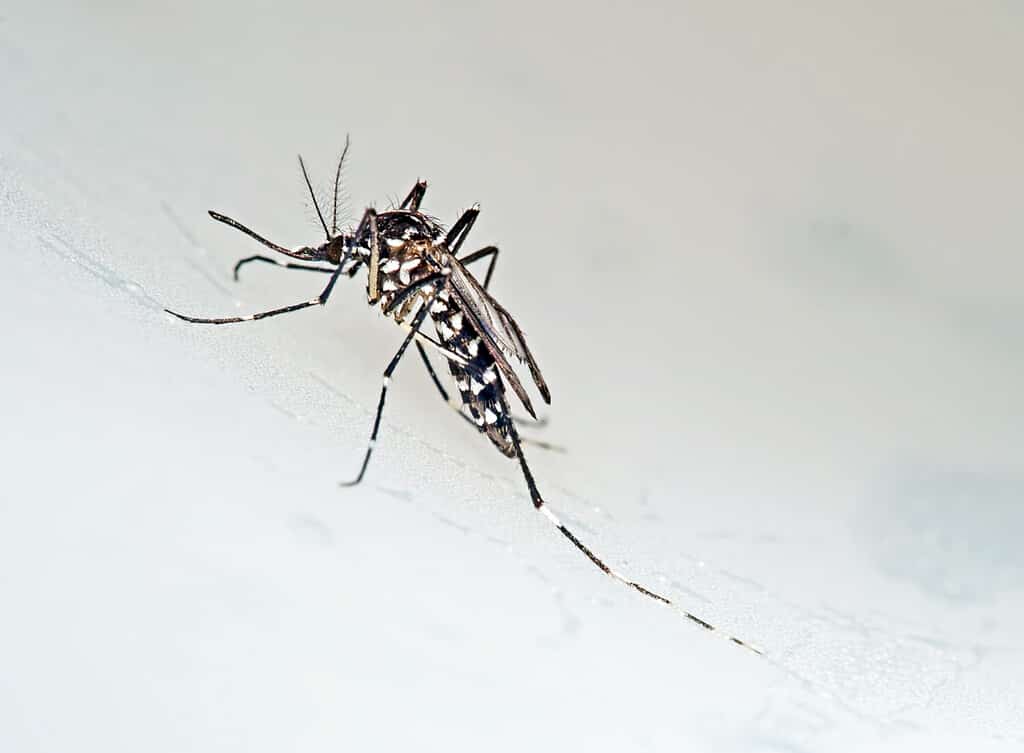
They are easy to recognize with dark brown abdomens and white scales that create tiger-like stripes.
©Sarah2/Shutterstock.com
The Asian tiger mosquito, originally from Asia as the name implies, has expanded its range across the majority of the states in the United States, including North Carolina.
With its distinct white and black appearance, the Asian tiger mosquito displays a pattern reminiscent of a tiger, hence its name. It features a central white stripe on its head and back, along with white bands adorning its legs.
During the larval stage, these mosquitoes sustain themselves by consuming small particles of debris and bacteria found in water sources. Male mosquitoes nourish themselves by feeding on plant juices and do not engage in biting behavior. In comparison, female mosquitoes need a blood meal to support the growth of their eggs.
Notably, the Asian tiger mosquito prefers biting in forested areas during daylight hours, earning it the moniker “forest day mosquito.”
The presence of these troublesome insects poses a significant threat to numerous individuals, as they harbor potentially life-threatening viruses like dengue, Zika, and chikungunya.
These mosquitoes emerge in force between April and October, aligning with the warm and humid weather conditions that facilitate their rapid reproduction.
4. Yellow Fever Mosquito (Aedes aegypti)
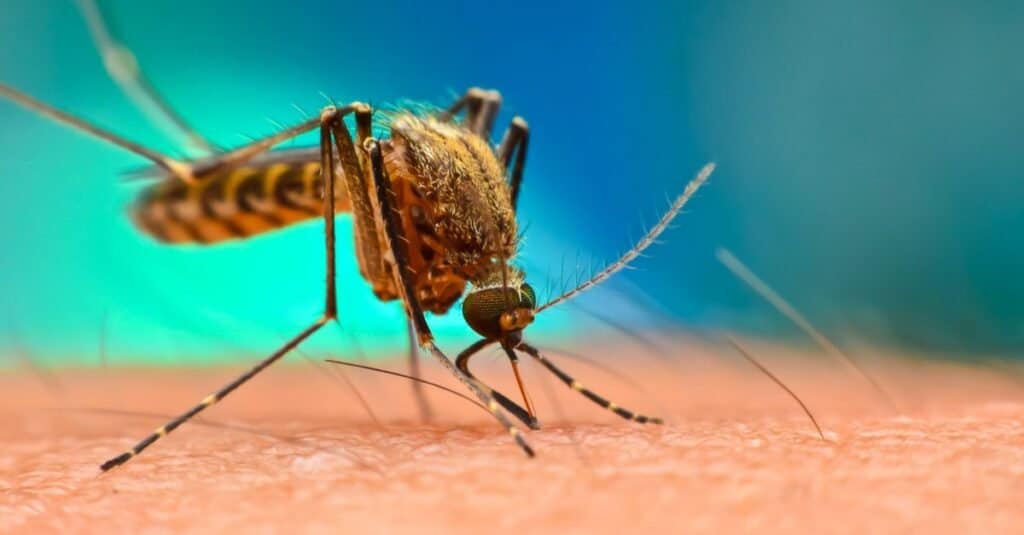
When it comes to selecting hosts, the yellow fever mosquito shows a preference for humans.
©Digital Images Studio/Shutterstock.com
Much like its close relative, the Asian tiger mosquito, the yellow fever mosquito exhibits remarkable beauty when observed on a microscopic level. Its body and legs are adorned with sleek jet-black scales, complemented by striking silvery-white scales on the sides of its thorax and abdomen. Additionally, each leg segment is distinguished by the presence of white bands.
The yellow fever mosquito mostly inhabits containers, often breeding in various locations such as spare tires, drainage ditches, untreated swimming pools, and unused flowerpots. Its adaptability to urbanized areas and close interaction with humans contribute to its remarkable success as a disease vector.
When it comes to selecting hosts, the yellow fever mosquito shows a preference for humans, although it occasionally feeds on cats, dogs, and rodents. Significantly, this mosquito is accountable for spreading not only yellow fever but also the West Nile virus, chikungunya, dengue, and the more recent Zika virus. With that said, yellow fever is not present in North Carolina, as the state is not within the range of the virus.
Although active from spring until the first frost, the yellow fever mosquito exhibits increased activity during the summer months in North Carolina.
5. Gallinipper Mosquito (Psorophora ciliata)
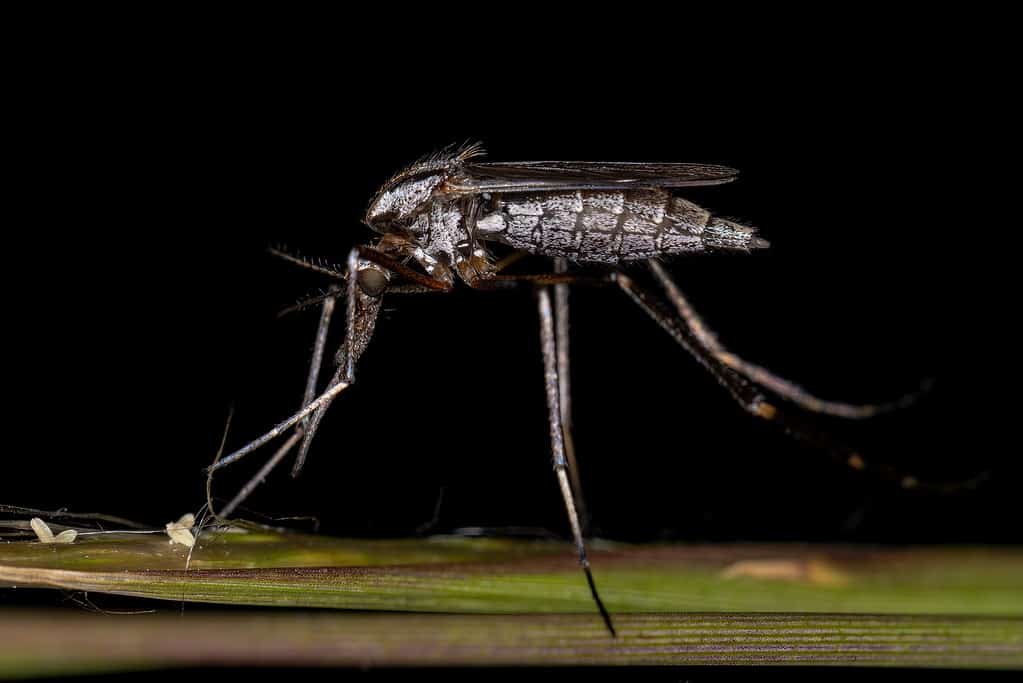
These formidable insects are commonly associated with periods of flooding and possess a formidable bite.
©Vinicius R. Souza/Shutterstock.com
Gallinipper mosquitoes are considered one of the largest mosquito species on Earth. These formidable insects are commonly associated with periods of flooding and possess a formidable bite, often described as a stabbing sensation.
Measuring approximately the size of a quarter, gallinippers possess distinctive legs adorned with shaggy hair and a striking zebra-like pattern. Their appearance is unmistakable.
Upon hatching, gallinipper larvae initially rely on filtering small organic particles for sustenance, much like their mosquito counterparts. However, as they undergo molting and growth, they adopt an unusual carnivorous habit, actively preying on other invertebrates that inhabit aquatic environments, including larvae of other mosquito species.
Notably, the female gallinipper exhibits a relentless pursuit of blood, displaying aggressive behavior regardless of the time of day or night. These mosquitoes breed in a variety of habitats, such as fields, temporary ground pools, and ditches. As adults, they can be found in fields and yards.
Similar to other mosquito species, gallinippers pose health risks as they have been found to carry diseases such as the West Nile virus and various strains of encephalitis, which can result in severe birth defects.
The spring and summer months bring with them the peak activity of gallinipper mosquitoes in North Carolina.
When Are Mosquitoes At Their Peak In North Carolina?
While mosquitoes in North Carolina can be seen from April to October, their peak activity can vary depending on several factors, including the specific location within the state and annual weather patterns.
Mosquitoes generally exhibit higher levels of activity during the warmer months in North Carolina, typically from May to September.
Other Insects Set To Emerge In North Carolina
Unfortunately, mosquitoes are not the only insects that come out during warm weather in North Carolina. The following insects are also set to appear once the days get longer.
1. Common Fruit Fly (Drosophila melanogaster)
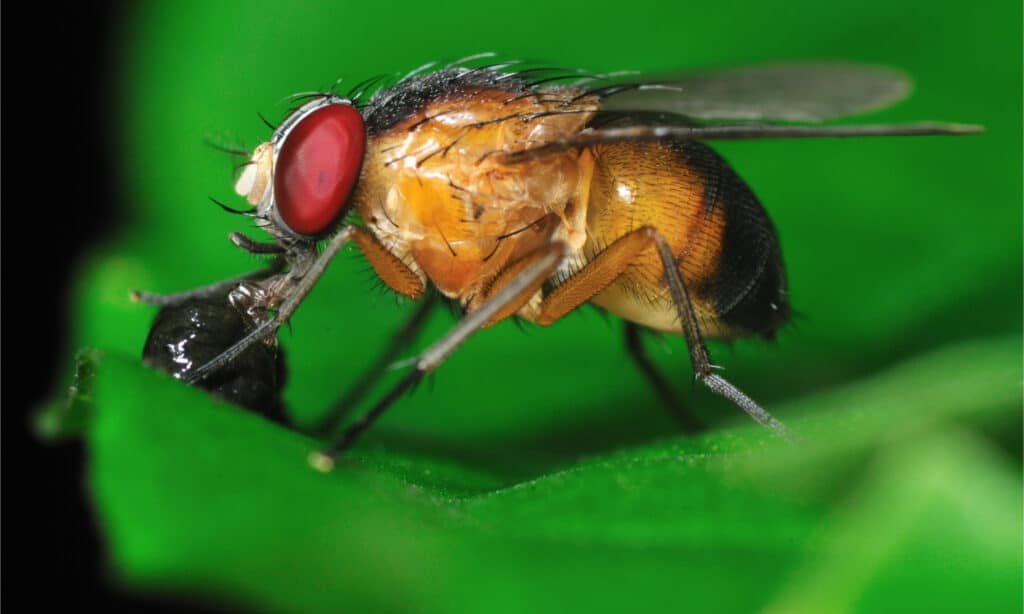
These flies utilize drains, garbage disposals, trash cans, and other moist objects as breeding sites.
©Jordan Lye/Shutterstock.com
In residential and commercial environments in North Carolina, the prevalent species of troublesome flies are commonly known as fruit flies.
These tiny oval-shaped flies have a maximum adult length of 1/8th of an inch. The color of their thorax is tan, while their abdomen is predominantly black with a gray underbelly. Overall, fruit flies appear tan in color, and some variations can have dark-colored eyes instead of typical red eyes.
Unlike mosquitoes, fruit flies do not serve as carriers of diseases. They do not spread infectious agents through biting or stinging. However, they can introduce bacteria into fruits through the wounds created by their egg-laying process. Consumption of infected fruit by humans can result in disease.
These flies utilize drains, garbage disposals, trash cans, and other moist objects as breeding sites.
Though fruit flies may show up throughout the year based on weather conditions, they’re most commonly observed during late summer and early fall.
2. Green June Beetle (Cotinis nitida)
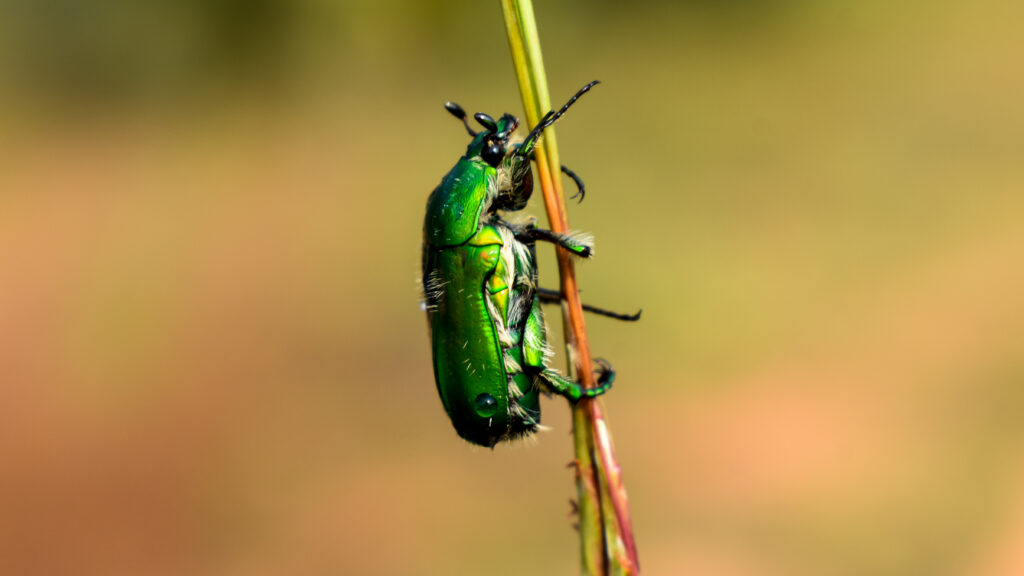
In their adult stage, green June beetles primarily consume fruits like apples, peaches, and figs.
©Sudhakar Bisen/Shutterstock.com
The green June beetle, an occasional nuisance for grape growers in North Carolina, displays a metallic green hue and measures almost an inch in length as an adult. Its body edges exhibit shades ranging from bronze to yellow, while the wing covers may be reddish-brown.
Sidewalks and driveways surrounding residential properties sometimes witness the appearance of numerous large, ivory-colored larvae. Homeowners may stumble upon hundreds or even thousands of these grubs.
Green June beetles possess an appealing appearance and pose no threat to humans.
In their adult stage, green June beetles primarily consume fruits like apples, peaches, and figs. They typically show a preference for ripe or decaying fruit. Occasionally, these adult beetles engage in excessive feeding, leading to economic losses for grape and small fruit growers.
The emergence of adult green June beetles in North Carolina takes place between late June and August. This period marks their peak activity as they search for food sources and potential mates.
3. Eastern Lubber Grasshopper (Romalea microptera)
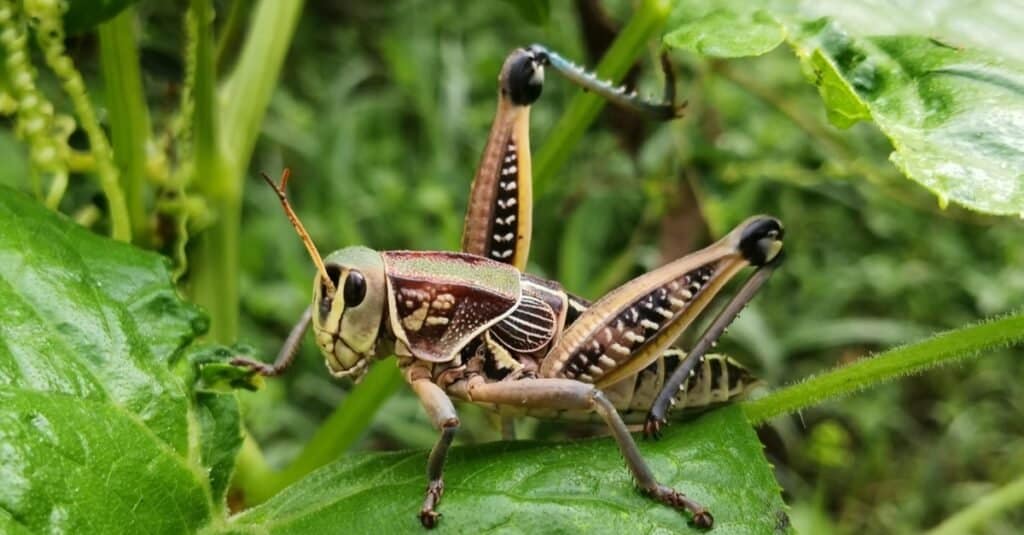
This particular grasshopper is notorious for its destructive nature, wreaking havoc on gardens in North Carolina.
©NEFS/Shutterstock.com
The southeastern region of the United States is home to a striking grasshopper species known as the eastern lubber.
This particular grasshopper is notorious for its destructive nature, wreaking havoc on gardens in North Carolina. The adult eastern lubber displays an array of vibrant colors, albeit with variations in their patterns. Their appearance often includes a dominant yellow or tawny hue, accompanied by distinct black markings on the antennae, pronotum, and abdominal segments.
Due to their size, eastern lubber grasshoppers are rather sluggish creatures, incapable of flight, and limited to short jumps. These grasshoppers, referred to as lubbers, have been known to feed on cultivated crops and gardens, but their preference is wild plants. Furthermore, despite their size, lubber grasshoppers do not cause as much damage as you may think. These grasshoppers consume less food than other smaller grasshopper species.
With a single generation per year, lubber grasshoppers experience a population surge during the late summer period. The months of July and August witness the peak activity of lubber grasshoppers, making it the most likely time for homeowners to encounter these creatures in their yards.
4. Monarch Butterfly (Danaus plexippus)

Famous for their striking looks, adult monarch butterflies present an enchanting visual.
©Media Marketing/Shutterstock.com
The North Carolina Wildlife Federation emphasizes the conservation of pollinators, with the monarch butterfly being a primary focus. Regrettably, these butterflies, along with other pollinators, have seen a considerable decline mainly due to the loss of natural habitats. Inappropriate pesticide usage and climate change effects have also impacted their population.
Famous for their striking looks, adult monarch butterflies present an enchanting visual. They have two sets of vivid wings in a brilliant orange-red color, featuring intricate black veins and refined white spots along the edges. Male monarch butterflies can be recognized by unique black dots on their wing veins, serving as a visual deterrent to possible predators.
Monarch butterflies can be spotted in North Carolina twice yearly. They are visible from May to July, as they return from wintering grounds. Again, they appear from mid-September to early October, as they head south.
5. Eastern Cicada Killer Wasp (Sphecius speciosus)
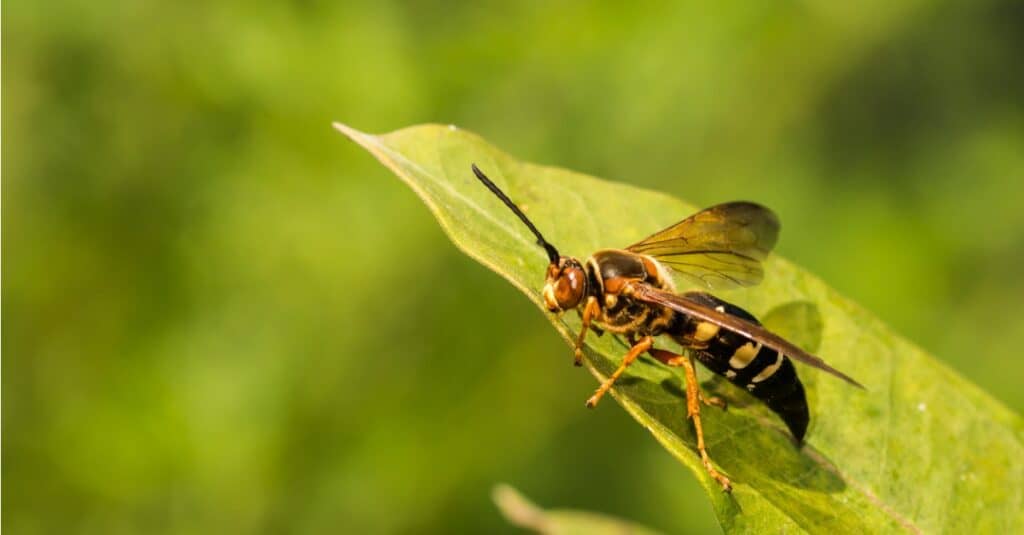
Female cicada killer wasps have formidable stingers, which they use to inject venom into cicadas.
©iStock.com/JasonOndreicka
The eastern cicada killer wasp holds the title of the most fearsome-looking wasp in North Carolina. It poses no threat to humans and is virtually harmless.
These wasps are quite large, measuring approximately two inches in length. Their bodies are predominantly black or dark brown, adorned with vibrant yellow markings on multiple segments of their abdomen. Sporting amber wings, they present a striking appearance.
Female cicada killer wasps have formidable stingers, which they use to inject venom into cicadas, leaving them paralyzed. Undeniably, their stings can be painful. Nonetheless, these wasps exhibit no aggression towards humans and lack the nest-guarding instinct commonly seen in honey bees and hornets.
These wasps are considered beneficial insects, vanishing once the cicadas perish in the fall. It is advisable not to eliminate cicada killers because they serve as insect predators and valuable pollinators. They do not cause any permanent damage to the landscape or harm plants.
In North Carolina, these wasps typically emerge in July and remain active throughout the entirety of the summer season.
The photo featured at the top of this post is © Surachai Pung/Shutterstock.com
Thank you for reading! Have some feedback for us? Contact the AZ Animals editorial team.



